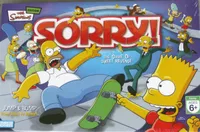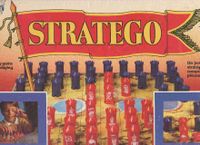Pit (1903)
Tiempo de Juego: 90
Edad Mínima: 7
Jugadores: 3 - 8
Editor: Russimco Games, Kaissa Chess & Games, Arclight Games, Clipper, Fractal Juegos, Winning Moves Games (USA), Editrice Giochi, Spear's Games, Nordic Games GmbH, John Waddington Ltd., Hasbro, Waddingtons, Holdson, Schmidt Spiele, Crown & Andrews Ltd., Editorial Dos Pasos, Korea Boardgames, Repos Production, Yetem S.A., Fundex, Copp Clark Publishing Company, Lighthouse Games, Top Cards, (Self-Published), Parker Brothers, Grimaud
Diseñadores: Edgar Cayce, George S. Parker, Harry Gavitt
Artistas: Nick the Rat, Andrea Trewhela, Olivier Fagnère, Thoren, Randy Asher, Paul Couture, Paul T., Peekasso
Mecánicas: Negotiation, Commodity Speculation, Trading, Real-Time, Set Collection
Edad Mínima: 7
Jugadores: 3 - 8
Editor: Russimco Games, Kaissa Chess & Games, Arclight Games, Clipper, Fractal Juegos, Winning Moves Games (USA), Editrice Giochi, Spear's Games, Nordic Games GmbH, John Waddington Ltd., Hasbro, Waddingtons, Holdson, Schmidt Spiele, Crown & Andrews Ltd., Editorial Dos Pasos, Korea Boardgames, Repos Production, Yetem S.A., Fundex, Copp Clark Publishing Company, Lighthouse Games, Top Cards, (Self-Published), Parker Brothers, Grimaud
Diseñadores: Edgar Cayce, George S. Parker, Harry Gavitt
Artistas: Nick the Rat, Andrea Trewhela, Olivier Fagnère, Thoren, Randy Asher, Paul Couture, Paul T., Peekasso
Mecánicas: Negotiation, Commodity Speculation, Trading, Real-Time, Set Collection
Mostrar Descripción Mostrar Comentarios Tendencia de Precios
Pit is an open-outcry commodity trading game. The first edition in 1903 had a deck of 63 cards, 9
each of 7 commodities, each with a value (ranging from 40 for Flax to 100 for Wheat). Players offer trades
by crying out the number of cards they want to swap (“One! One! One!”, or “Three!
Three! Three!”) but not their identity. The winner of the hand is the first to collect all of one
commodity, declaring “Corner on Wheat!” or whatever commodity has been collected. The
winner of the hand scores points equal to the value of the commodity, and the winner of the game is the
first to 500 points.
The 1904 Edition of Pit added much fancier artwork and the famous Bull and Bear cards, which provide wild-card and penalty features. The early editions allowed a maximum of 7 players, but later versions supported 8 and in at least one case up to 10.
Pit’s designer, noted psychic Edgar Cayce, is often accused of having stolen the idea from the game Gavitt’s Stock Exchange (G-S-E) invented by Harry Gavitt. While G-S-E claimed patents dating as early as 1896, it involved trading railway shares, and was only copyrighted and published in 1903, the same year as Pit. In addition, the only related patent assigned to Gavitt is US746492 A, filed October 7, 1903, and granted December 8, 1903. Also hitting the market in 1903 was Bourse', a remarkably similar open-outcry commodity trading game from Flinch Card Co., using an 80-card deck with 10 each of 8 commodities, and Panic, using a 65 card deck with 8 each of 8 commodities and a Panic card, roughly equivalent to the Bull. Pit, however, seems to have cornered the market on open-outcry games, as neither of its competitors were seen again after 1904.
The 1904 Edition of Pit added much fancier artwork and the famous Bull and Bear cards, which provide wild-card and penalty features. The early editions allowed a maximum of 7 players, but later versions supported 8 and in at least one case up to 10.
Pit’s designer, noted psychic Edgar Cayce, is often accused of having stolen the idea from the game Gavitt’s Stock Exchange (G-S-E) invented by Harry Gavitt. While G-S-E claimed patents dating as early as 1896, it involved trading railway shares, and was only copyrighted and published in 1903, the same year as Pit. In addition, the only related patent assigned to Gavitt is US746492 A, filed October 7, 1903, and granted December 8, 1903. Also hitting the market in 1903 was Bourse', a remarkably similar open-outcry commodity trading game from Flinch Card Co., using an 80-card deck with 10 each of 8 commodities, and Panic, using a 65 card deck with 8 each of 8 commodities and a Panic card, roughly equivalent to the Bull. Pit, however, seems to have cornered the market on open-outcry games, as neither of its competitors were seen again after 1904.
Actualmente no tenemos datos de precios para este juego.
Este juego actualmente no se comercia en el mercado:
Este juego actualmente no está listado en el mercado. Si quieres vender el tuyo, por favor añádelo al mercado.
Mercado
El juego también se publicó con estos nombres:
Business ,
Cambio ,
Board of Trade ,
Zaster ,
カードゲーム ピット デラックス ,
Ben 10 Pit ,
Αγελαδοπάζαρο ,
ピット ,
Trading Pitt ,
Billionaire ,
핏 딜럭스 ,
Get Rich Quick ,
La Feria de las Pulgas de Titirilquén ,
Pit ,
Pit: The Greatest of all Party Games ,
Quick 7 ,
NO AGENDA: the Card Game ,
Deluxe Pit ,
Classic Pit ,
Zeven 7 ,
Gavitt's Stock Exchange ,
Ding!
Juegos Relacionados
ag.gameitem.lastUpdated: 2025-04-29 03:03:07.504















